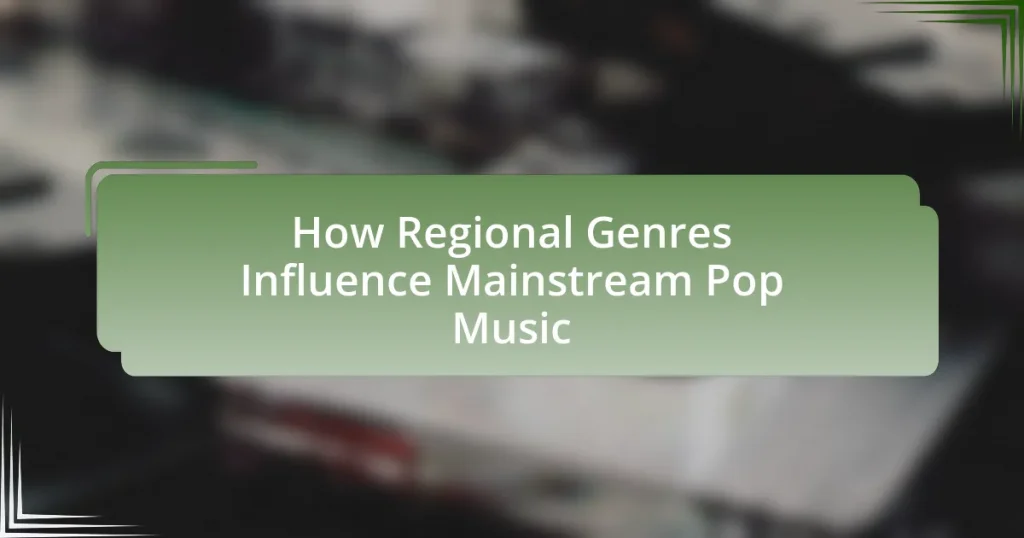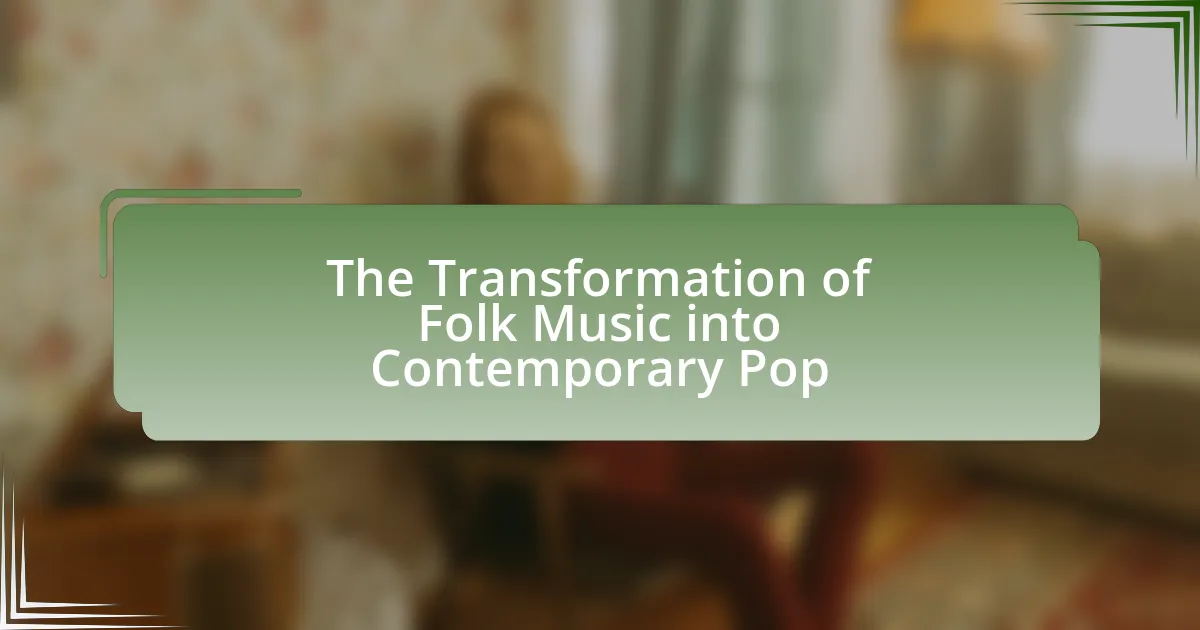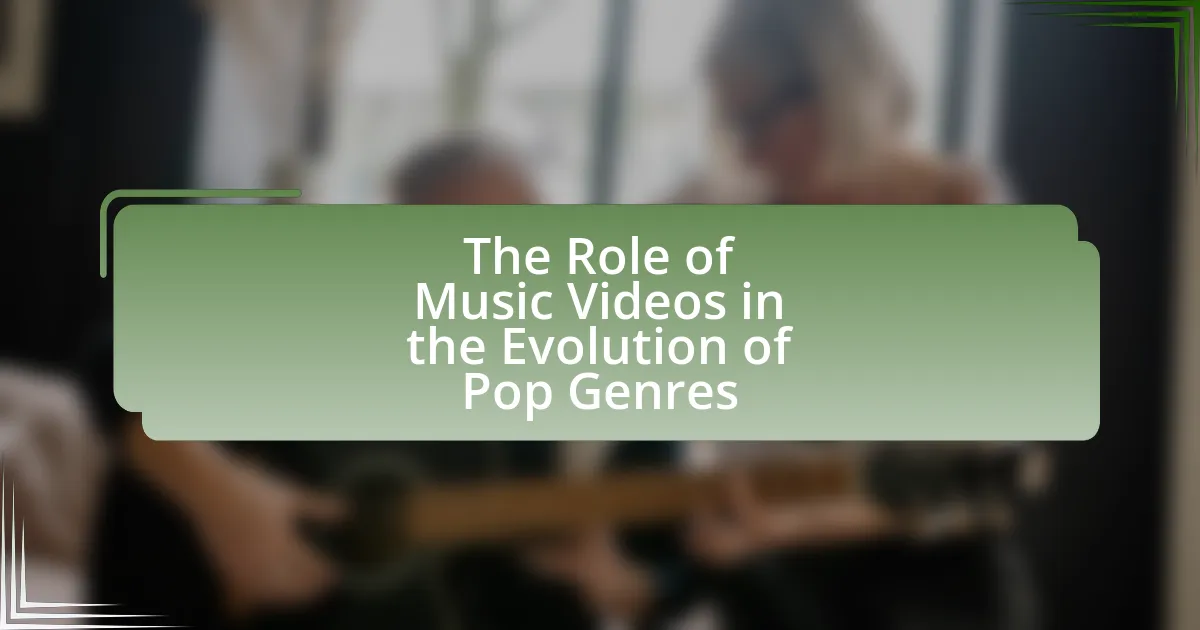The article examines how regional genres influence mainstream pop music by introducing diverse sounds, rhythms, and cultural elements that enhance the genre’s appeal and creativity. It highlights the impact of Latin music, K-pop, and Afrobeats on contemporary pop, showcasing successful artists who have integrated these regional influences into their work. The discussion includes the characteristics of regional genres, the importance of cultural exchange, and the challenges artists face when blending genres. Additionally, it emphasizes best practices for artists to ensure authenticity and respect for the cultural origins of the music they incorporate.
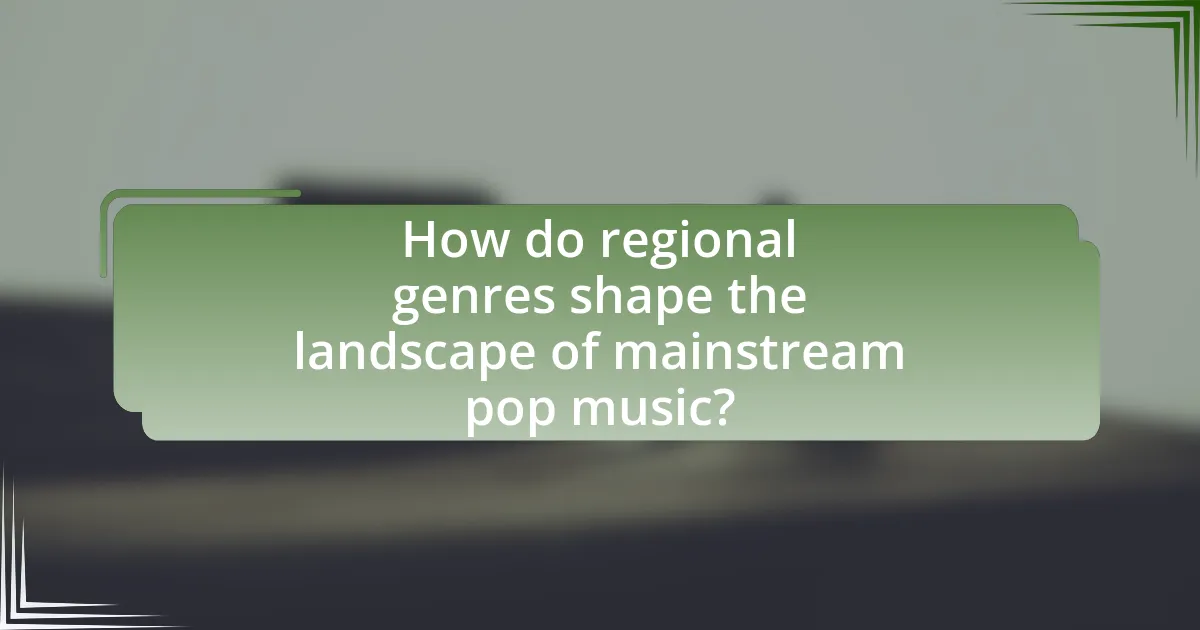
How do regional genres shape the landscape of mainstream pop music?
Regional genres significantly shape the landscape of mainstream pop music by introducing diverse sounds, rhythms, and cultural influences that broaden the appeal and creativity of the genre. For instance, the incorporation of Latin rhythms in pop music, exemplified by the success of artists like Shakira and Bad Bunny, has led to a surge in reggaeton and Latin pop’s popularity in the mainstream, evidenced by chart-topping hits and collaborations with major pop artists. Additionally, the rise of K-pop has transformed global music consumption patterns, as groups like BTS and BLACKPINK blend traditional Korean music elements with Western pop, resulting in unprecedented international success and a new audience demographic. These regional influences not only diversify the sonic palette of mainstream pop but also reflect and promote cultural exchange, making the genre more inclusive and representative of global music trends.
What are regional genres and how do they differ from mainstream pop?
Regional genres are music styles that originate from specific geographic areas and reflect the cultural, social, and historical contexts of those regions. They differ from mainstream pop in that regional genres often prioritize local traditions, languages, and instruments, while mainstream pop typically emphasizes broad commercial appeal, often utilizing universal themes and production techniques designed for mass consumption. For example, genres like Tejano in Texas or Fado in Portugal showcase unique cultural elements that are not typically found in mainstream pop music, which tends to favor a more homogenized sound aimed at a global audience.
What characteristics define regional genres?
Regional genres are defined by distinct cultural, musical, and linguistic characteristics that reflect the identity of a specific geographic area. These genres often incorporate local instruments, traditional rhythms, and unique lyrical themes that resonate with the experiences and values of the community. For example, the use of the accordion in Tex-Mex music highlights regional instrumentation, while the incorporation of local dialects in lyrics emphasizes cultural identity. Additionally, regional genres often evolve through the blending of influences from neighboring cultures, which can lead to the creation of hybrid styles that further enrich the musical landscape.
How do cultural influences shape these regional genres?
Cultural influences shape regional genres by integrating local traditions, languages, and social practices into the music, creating distinct sounds and styles. For example, the incorporation of African rhythms and instruments in American blues and jazz reflects the cultural heritage of African American communities. Additionally, regional genres often draw from historical events and societal changes, such as the impact of immigration on the development of genres like Tejano music in Texas, which blends Mexican and American influences. These cultural elements not only define the genre’s identity but also contribute to its evolution, as seen in the way hip-hop has absorbed influences from various cultures, leading to diverse sub-genres worldwide.
Why is it important to study the influence of regional genres on mainstream pop?
Studying the influence of regional genres on mainstream pop is important because it reveals how diverse cultural expressions shape popular music trends. Regional genres often introduce unique rhythms, melodies, and lyrical themes that can enhance the richness of mainstream pop, making it more relatable to a broader audience. For instance, the incorporation of Latin rhythms in pop music has led to significant chart successes, as seen with artists like Shakira and Bad Bunny, who have brought regional sounds to global prominence. This blending not only reflects cultural exchange but also drives innovation in music, influencing production techniques and songwriting styles. Understanding these influences can help industry stakeholders identify emerging trends and cater to evolving listener preferences.
What historical context supports the blending of regional genres into pop music?
The historical context supporting the blending of regional genres into pop music includes the globalization of music through technological advancements and cultural exchanges. In the mid-20th century, the advent of radio, television, and later the internet facilitated the dissemination of diverse musical styles across geographical boundaries. For instance, the rise of rock and roll in the 1950s incorporated elements from rhythm and blues, country, and folk, reflecting a melting pot of influences. Additionally, the 1980s and 1990s saw the emergence of hip-hop, which drew from funk, soul, and various regional sounds, further illustrating the integration of different genres into mainstream music. This blending is evidenced by the commercial success of artists like Shakira, who combines Latin rhythms with pop, and the widespread popularity of K-pop, which fuses Korean music with Western pop influences. These examples highlight how historical developments in technology and cultural exchange have enabled the fusion of regional genres into the broader pop music landscape.
How does understanding this influence benefit artists and producers?
Understanding the influence of regional genres on mainstream pop music benefits artists and producers by enabling them to create more culturally relevant and diverse content. This understanding allows artists to tap into unique sounds and styles that resonate with specific audiences, thereby expanding their reach and appeal. For instance, the incorporation of Latin rhythms in pop music has led to significant chart success, as seen with artists like Shakira and Bad Bunny, who have achieved global recognition by blending regional influences with mainstream elements. This strategic fusion not only enhances the artistic authenticity of the music but also drives commercial success, as evidenced by the increased sales and streaming numbers associated with genre-blending tracks.
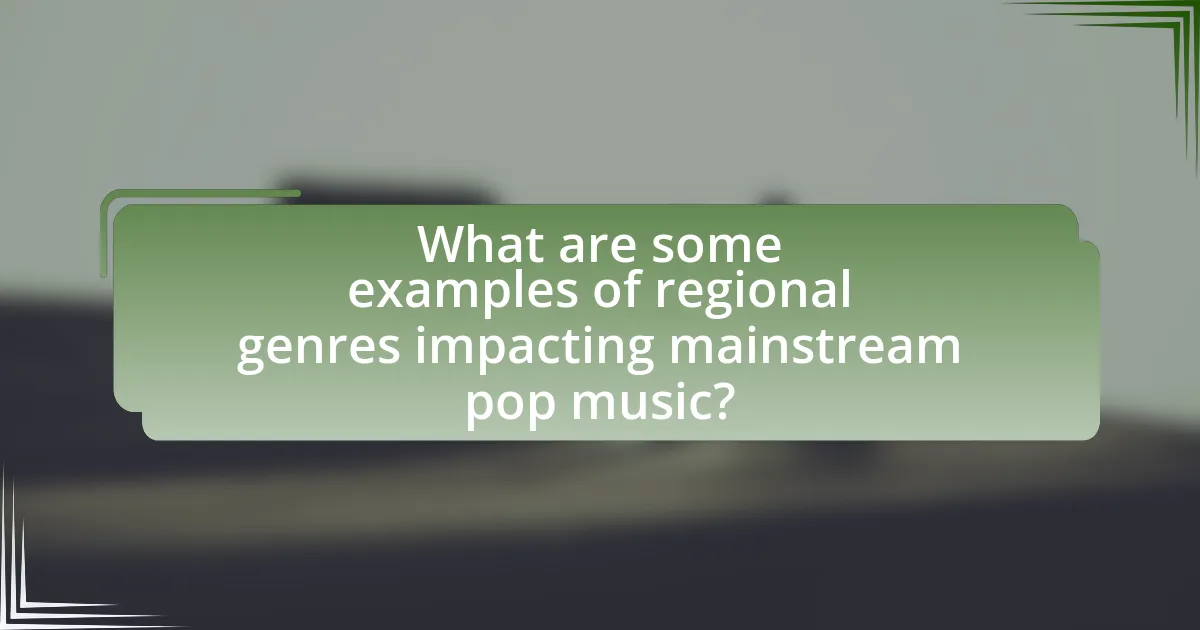
What are some examples of regional genres impacting mainstream pop music?
Regional genres such as reggaeton, K-pop, and Afrobeats have significantly impacted mainstream pop music. Reggaeton, originating from Puerto Rico, has influenced artists like Justin Bieber and Cardi B, leading to chart-topping hits that incorporate its rhythmic elements. K-pop, with its roots in South Korea, has gained global popularity, exemplified by groups like BTS and BLACKPINK, who blend pop with traditional Korean music styles, achieving record-breaking sales and streaming numbers. Afrobeats, emerging from West Africa, has shaped the sound of mainstream pop through artists like Wizkid and Burna Boy, whose collaborations with Western artists have brought African rhythms to a broader audience. These genres demonstrate how regional sounds can reshape the landscape of pop music, driving trends and expanding cultural boundaries.
How has Latin music influenced contemporary pop hits?
Latin music has significantly influenced contemporary pop hits by introducing rhythmic elements, melodic structures, and cultural themes that enhance mainstream appeal. For instance, the incorporation of reggaeton beats, as seen in tracks like “Despacito” by Luis Fonsi featuring Daddy Yankee, has led to widespread chart success, with the song topping the Billboard Hot 100 for 16 weeks in 2017. Additionally, artists such as Shakira and J Balvin have blended Latin sounds with pop, resulting in hits like “Hips Don’t Lie” and “Mi Gente,” which showcase the fusion of genres and have garnered billions of streams globally. This cross-pollination has not only diversified the sound of pop music but also expanded its audience, reflecting a growing acceptance and celebration of Latin culture in the music industry.
What specific elements from Latin music have been adopted in pop songs?
Latin music has significantly influenced pop songs through elements such as rhythmic patterns, instrumentation, and vocal styles. For instance, the incorporation of reggaeton beats, characterized by a dembow rhythm, has become prevalent in mainstream pop, as seen in hits like “Despacito” by Luis Fonsi featuring Justin Bieber. Additionally, instruments like the guitar and brass sections, commonly found in Latin genres, have been integrated into pop arrangements, enhancing the overall sound. Furthermore, vocal techniques such as call-and-response and the use of Spanish lyrics in pop songs have also emerged, reflecting the cultural blend and appeal of Latin music in the pop landscape.
Which artists have successfully integrated Latin influences into their music?
Artists such as Shakira, Jennifer Lopez, and Marc Anthony have successfully integrated Latin influences into their music. Shakira’s blend of pop and Latin rhythms, particularly in songs like “Hips Don’t Lie,” showcases her Colombian roots and has garnered international acclaim. Jennifer Lopez incorporates elements of salsa and reggaeton in tracks like “On The Floor,” reflecting her Puerto Rican heritage and achieving significant commercial success. Marc Anthony, known for his salsa music, has crossed over into mainstream pop with hits like “Vivir Mi Vida,” which emphasizes the influence of Latin music on broader audiences. These artists exemplify how Latin influences have shaped and enriched mainstream pop music.
In what ways has African music shaped modern pop trends?
African music has significantly shaped modern pop trends through its rhythmic complexity, instrumentation, and vocal styles. The incorporation of African rhythms, such as those found in Afrobeats and Highlife, has influenced global pop music, leading to the creation of hybrid genres that blend traditional African sounds with contemporary pop elements. For instance, artists like Beyoncé and Drake have integrated African musical styles into their work, showcasing the global appeal of these rhythms. Additionally, the use of traditional instruments like the djembe and kora in modern pop tracks has introduced unique textures and sounds that differentiate contemporary music from its predecessors. This fusion has not only broadened the sonic palette of pop music but has also increased the visibility of African artists on the global stage, further solidifying the impact of African music on modern pop trends.
What rhythmic and melodic elements from African music are prevalent in pop?
African music contributes several rhythmic and melodic elements to pop music, notably polyrhythms, syncopation, and call-and-response patterns. Polyrhythms, which involve multiple contrasting rhythms played simultaneously, create a complex and engaging sound that is often found in contemporary pop tracks. Syncopation, the emphasis on off-beats, adds a dynamic quality to the music, making it more danceable and appealing to listeners. Additionally, call-and-response patterns, where a leader sings or plays a phrase and a group responds, foster interaction and community, which are increasingly incorporated into pop performances. These elements have been validated by the widespread adoption of African-inspired beats in global hits, demonstrating their significant influence on the evolution of pop music.
How have collaborations with African artists impacted mainstream pop?
Collaborations with African artists have significantly enriched mainstream pop by introducing diverse rhythms, melodies, and cultural narratives. For instance, the fusion of Afrobeats with pop music has led to chart-topping hits, such as Wizkid’s collaboration with Drake on “One Dance,” which topped the Billboard Hot 100 in 2016 and showcased the global appeal of African sounds. Additionally, artists like Burna Boy and Tiwa Savage have gained international recognition, further influencing pop music trends and expanding the genre’s sonic palette. This integration not only broadens the audience for African music but also encourages cross-cultural exchanges, making mainstream pop more inclusive and representative of global musical landscapes.

How can artists effectively incorporate regional genres into their pop music?
Artists can effectively incorporate regional genres into their pop music by blending traditional elements, such as instrumentation and rhythms, with contemporary pop structures. For instance, artists like Shakira have successfully integrated Colombian cumbia and vallenato into mainstream pop, creating a unique sound that resonates globally. This approach not only preserves cultural authenticity but also attracts diverse audiences, as evidenced by the global success of songs like “Hips Don’t Lie,” which features traditional Latin sounds while adhering to pop sensibilities. By collaborating with regional musicians and utilizing local instruments, artists can further enhance the authenticity and appeal of their music, thereby enriching the pop genre with diverse cultural influences.
What strategies can artists use to blend regional sounds with pop?
Artists can blend regional sounds with pop by incorporating traditional instruments, utilizing local rhythms, and collaborating with regional musicians. For instance, using instruments like the sitar in pop music can create a unique sound that resonates with both regional and mainstream audiences. Additionally, integrating local rhythms, such as the Afrobeat’s syncopation, can enhance the pop structure while maintaining cultural authenticity. Collaborations with regional artists not only bring authenticity but also expand the audience reach, as seen in the success of artists like Shakira, who fused Latin sounds with pop, resulting in global hits.
How can collaboration with regional artists enhance authenticity?
Collaboration with regional artists enhances authenticity by integrating local cultural elements and perspectives into mainstream music. This partnership allows for the infusion of unique sounds, traditional instruments, and storytelling techniques that reflect the true essence of a specific region. For example, the collaboration between American pop artists and regional musicians from Latin America has led to the popularization of genres like reggaeton, which incorporates local rhythms and languages, thereby creating a more genuine representation of diverse cultures in mainstream music. This authenticity resonates with audiences, fostering a deeper connection and appreciation for the music.
What role does cultural research play in this integration process?
Cultural research plays a crucial role in the integration process of regional genres into mainstream pop music by providing insights into the unique characteristics, values, and preferences of diverse cultural groups. This understanding enables artists and producers to authentically incorporate elements from various regional genres, ensuring that the music resonates with a broader audience while maintaining its cultural integrity. For instance, studies have shown that the fusion of traditional sounds with contemporary pop can enhance listener engagement and expand market reach, as evidenced by the success of artists like Shakira, who blends Latin rhythms with pop sensibilities. Thus, cultural research not only informs creative decisions but also supports the commercial viability of music that draws from multiple cultural influences.
What are the potential challenges artists face when merging genres?
Artists face several potential challenges when merging genres, including audience expectations, identity confusion, and marketability issues. Audience expectations can create pressure for artists to conform to established norms within specific genres, making it difficult to innovate. Identity confusion arises when artists blend genres, potentially alienating fans who prefer their original sound. Marketability issues can occur as record labels and promoters may struggle to categorize the artist, complicating promotional strategies. These challenges are evident in the music industry, where artists like Lil Nas X faced backlash for genre-blending, yet also achieved significant success, illustrating the complex dynamics at play.
How can artists navigate cultural appropriation concerns?
Artists can navigate cultural appropriation concerns by engaging in thorough research and understanding the cultural significance of the elements they wish to incorporate into their work. This involves recognizing the historical context and the meanings behind specific cultural symbols, practices, or styles. For instance, artists should seek to collaborate with members of the culture they are drawing from, ensuring that their representation is authentic and respectful. Additionally, artists can prioritize giving credit and compensation to the original creators, which fosters a sense of respect and acknowledgment. Research indicates that artists who actively engage with the communities they draw inspiration from can create more meaningful and ethically sound work, thereby reducing the risk of cultural appropriation.
What are common pitfalls to avoid when blending regional genres with pop?
Common pitfalls to avoid when blending regional genres with pop include cultural appropriation, lack of authenticity, and oversimplification of musical elements. Cultural appropriation occurs when artists adopt elements from a regional genre without understanding or respecting its origins, which can lead to backlash from the original community. Lack of authenticity arises when artists fail to incorporate genuine aspects of the regional genre, resulting in a product that feels inauthentic and disconnected. Oversimplification of musical elements can dilute the richness of the regional genre, leading to a sound that lacks depth and fails to resonate with audiences familiar with the original style. These pitfalls can undermine the integrity of both the regional genre and the pop music it seeks to blend with.
What best practices can artists follow to ensure successful genre blending?
Artists can ensure successful genre blending by deeply understanding the characteristics and cultural contexts of the genres they wish to merge. This foundational knowledge allows artists to create authentic and innovative combinations that resonate with audiences. For instance, artists like Lil Nas X successfully blended country and hip-hop by incorporating traditional country themes and instrumentation while maintaining hip-hop’s rhythmic and lyrical style, resulting in widespread appeal and chart success. Additionally, collaboration with artists from different genres can enhance creativity and provide fresh perspectives, as seen in the collaborations between pop and Latin artists that have led to hits like “Despacito.” By experimenting with instrumentation, rhythm, and lyrical themes while respecting the origins of each genre, artists can create unique sounds that attract diverse listeners.
